Predicting the Impact of Rainfall on Paddy Harvest and Agricultural Loans in Sri Lanka
Predicting the impact of rainfall on paddy harvest and its ultimate effect on agricultural loans in banks in Sri Lanka
94 Pages33895 Words82 Views
Added on 2023-01-19
About This Document
This research report aims to predict the impact of rainfall on paddy harvest and its effect on agricultural loans in banks in Sri Lanka. It discusses the problem statement, research questions, background of the study, and the importance of the study.
Predicting the Impact of Rainfall on Paddy Harvest and Agricultural Loans in Sri Lanka
Predicting the impact of rainfall on paddy harvest and its ultimate effect on agricultural loans in banks in Sri Lanka
Added on 2023-01-19
ShareRelated Documents
CMM799 MSc Project (BA)
Predicting the impact of rainfall on paddy harvest and its ultimate effect on
agricultural loans in banks in Sri Lanka
MSc Business Analytics Research Project
Student ID# 2017030
RGU# 1616183
Predicting the impact of rainfall on paddy harvest and its ultimate effect on
agricultural loans in banks in Sri Lanka
MSc Business Analytics Research Project
Student ID# 2017030
RGU# 1616183
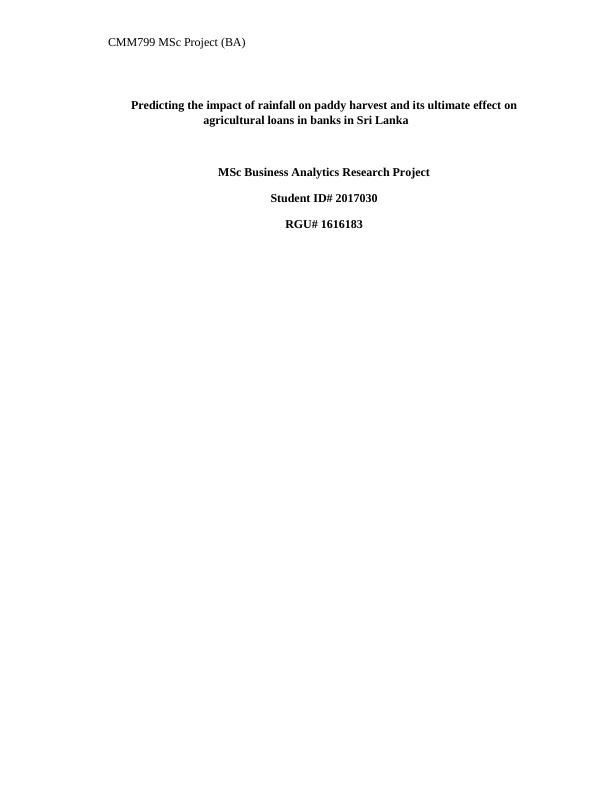
1
CMM799 MSc Project (BA)
Contents
Chapter 1: Introduction (10 p)................................................................................................4
1.1. Problem Statement..............................................................................................................4
1.2. Research Questions.............................................................................................................4
1.3. Background of the Study.....................................................................................................5
1.3.1. Importance of agriculture in Sri Lanka.........................................................................5
1.3.2. Importance of agriculture loans in Sri Lanka...............................................................5
1.3.3. Importance of this study...............................................................................................6
1.4. Aims and Objectives of the Study.......................................................................................8
1.5. Scope of the Study...............................................................................................................8
1.6. Software Tools and Databases to be used............................................................................9
1.7. Deliverables of the Study....................................................................................................9
1.8. Content Outline of Main Chapters.......................................................................................9
Chapter 2: Literature Review ( 20 p)....................................................................................12
2.1. Introduction.......................................................................................................................12
2.2. Paddy as a main agricultural produce in Sri Lanka............................................................12
2.3. Brief overview of agricultural practices and climatic conditions related to paddy.............12
2.4. Agricultural loans in Sri Lanka and the Asian region........................................................13
2.5. Factors that contribute to agricultural loan loss: Causes....................................................16
2.6. Predicting Weather Patterns........................................................................................19
2.7. Impact of environmental hazard on agricultural Loan Loss...........................................20
2.8 Innovations in weather risk management in Banks.......................................................22
2.8.1 Risk Mitigation..........................................................................................................22
2.8.2 Global Engagements..................................................................................................24
2.9. Chapter Summary..............................................................................................................24
Chapter 3: Research Methodology (5 p)...............................................................................26
3.1. Introduction.......................................................................................................................26
3.2. Method Outline..................................................................................................................26
3.2.1 Overview of steps in the methodology............................................................................26
3.2.2 Proposed formula.............................................................................................................29
3.3. Research Philosophy.........................................................................................................29
3.3.1.Justification for choosing Positivism Research Philosophy..........................................31
3.4. Research Approach............................................................................................................31
CMM799 MSc Project (BA)
Contents
Chapter 1: Introduction (10 p)................................................................................................4
1.1. Problem Statement..............................................................................................................4
1.2. Research Questions.............................................................................................................4
1.3. Background of the Study.....................................................................................................5
1.3.1. Importance of agriculture in Sri Lanka.........................................................................5
1.3.2. Importance of agriculture loans in Sri Lanka...............................................................5
1.3.3. Importance of this study...............................................................................................6
1.4. Aims and Objectives of the Study.......................................................................................8
1.5. Scope of the Study...............................................................................................................8
1.6. Software Tools and Databases to be used............................................................................9
1.7. Deliverables of the Study....................................................................................................9
1.8. Content Outline of Main Chapters.......................................................................................9
Chapter 2: Literature Review ( 20 p)....................................................................................12
2.1. Introduction.......................................................................................................................12
2.2. Paddy as a main agricultural produce in Sri Lanka............................................................12
2.3. Brief overview of agricultural practices and climatic conditions related to paddy.............12
2.4. Agricultural loans in Sri Lanka and the Asian region........................................................13
2.5. Factors that contribute to agricultural loan loss: Causes....................................................16
2.6. Predicting Weather Patterns........................................................................................19
2.7. Impact of environmental hazard on agricultural Loan Loss...........................................20
2.8 Innovations in weather risk management in Banks.......................................................22
2.8.1 Risk Mitigation..........................................................................................................22
2.8.2 Global Engagements..................................................................................................24
2.9. Chapter Summary..............................................................................................................24
Chapter 3: Research Methodology (5 p)...............................................................................26
3.1. Introduction.......................................................................................................................26
3.2. Method Outline..................................................................................................................26
3.2.1 Overview of steps in the methodology............................................................................26
3.2.2 Proposed formula.............................................................................................................29
3.3. Research Philosophy.........................................................................................................29
3.3.1.Justification for choosing Positivism Research Philosophy..........................................31
3.4. Research Approach............................................................................................................31
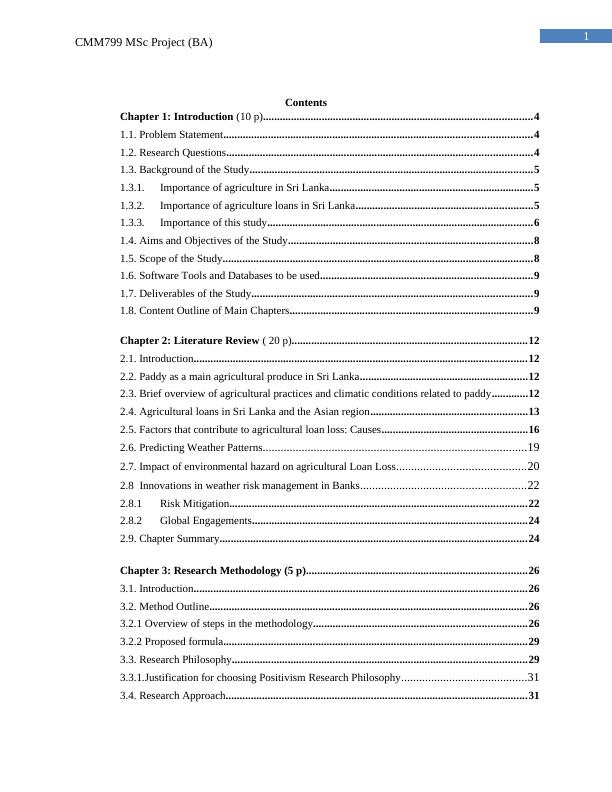
2
CMM799 MSc Project (BA)
3.4.1. Justification for choosing Inductive Approach...........................................................32
3.5. Research Design................................................................................................................32
3.5.1. Justification for selecting Descriptive Research Design..............................................33
3.6. Data Collection Methodology............................................................................................33
3.7. Data Analysis Method.......................................................................................................34
3.7.1. Data Analysis Method Chosen.................................................................................35
3.8. Population and Sample......................................................................................................35
3.9. Ethical Considerations.......................................................................................................35
Chapter 4: Requirement Analysis ( 5 p)...............................................................................37
4.1. Overview of Requirement analysis....................................................................................37
4.2 Requirements Analysis Process..........................................................................................37
4.3 Elicit Requirements............................................................................................................37
4.3.1 Factors which influence the agricultural production (Rainfall)........................................38
4.3.2 What impacts will the changing rainfall patterns have on the patterns of the crop?.........39
4.4. Research Requirements.....................................................................................................39
4.5. Data Gathering and Preprocessing.....................................................................................39
4.6 Chapter Summary...............................................................................................................41
Chapter 5: Design of the Solution ( 15 -20 p)........................................................................42
5.1. Introduction.......................................................................................................................42
5.2. Design Steps......................................................................................................................42
5.3. Details of the Solution Design...........................................................................................43
5.4 Theoretical Rationale of Design Solution...........................................................................45
5.4.1 Structure of Multivariate Regression Model....................................................................45
5.4.2 Objective of the Multi-Variate model..............................................................................45
5.4.3 Detailed Discussion of the Theoretical Rationale of the Model.......................................46
5.5 Chapter Summary...............................................................................................................49
Chapter 6: Implementation ( 5 -10 p)...................................................................................50
6.1. Introduction.......................................................................................................................50
6.2 Visualization.......................................................................................................................50
6.3 Descriptive Statistics..........................................................................................................53
6.4 Data Preparation from modelling.......................................................................................54
Chapter 7: Testing and Evaluation ( 5 -10 p).......................................................................57
CMM799 MSc Project (BA)
3.4.1. Justification for choosing Inductive Approach...........................................................32
3.5. Research Design................................................................................................................32
3.5.1. Justification for selecting Descriptive Research Design..............................................33
3.6. Data Collection Methodology............................................................................................33
3.7. Data Analysis Method.......................................................................................................34
3.7.1. Data Analysis Method Chosen.................................................................................35
3.8. Population and Sample......................................................................................................35
3.9. Ethical Considerations.......................................................................................................35
Chapter 4: Requirement Analysis ( 5 p)...............................................................................37
4.1. Overview of Requirement analysis....................................................................................37
4.2 Requirements Analysis Process..........................................................................................37
4.3 Elicit Requirements............................................................................................................37
4.3.1 Factors which influence the agricultural production (Rainfall)........................................38
4.3.2 What impacts will the changing rainfall patterns have on the patterns of the crop?.........39
4.4. Research Requirements.....................................................................................................39
4.5. Data Gathering and Preprocessing.....................................................................................39
4.6 Chapter Summary...............................................................................................................41
Chapter 5: Design of the Solution ( 15 -20 p)........................................................................42
5.1. Introduction.......................................................................................................................42
5.2. Design Steps......................................................................................................................42
5.3. Details of the Solution Design...........................................................................................43
5.4 Theoretical Rationale of Design Solution...........................................................................45
5.4.1 Structure of Multivariate Regression Model....................................................................45
5.4.2 Objective of the Multi-Variate model..............................................................................45
5.4.3 Detailed Discussion of the Theoretical Rationale of the Model.......................................46
5.5 Chapter Summary...............................................................................................................49
Chapter 6: Implementation ( 5 -10 p)...................................................................................50
6.1. Introduction.......................................................................................................................50
6.2 Visualization.......................................................................................................................50
6.3 Descriptive Statistics..........................................................................................................53
6.4 Data Preparation from modelling.......................................................................................54
Chapter 7: Testing and Evaluation ( 5 -10 p).......................................................................57

3
CMM799 MSc Project (BA)
7.1. Introduction.......................................................................................................................57
7.2 Autocorrelation: ACF and PACF.......................................................................................57
7.3 Mean Absolute Percentage Error- MAPE and Root-Mean-Square Error-RMSE................58
7.4 Change Point......................................................................................................................58
7.5 Prediction...........................................................................................................................60
7.6 Review of professional, social, legal and ethical issues......................................................61
7.7 Test Plan.............................................................................................................................62
7.8 Original objectives versus objectives achieved...................................................................63
7.9 Chapeter 6 & 7 Summary...................................................................................................64
Chapter 8: Conclusion...........................................................................................................74
8.1 Overall Conclusion.............................................................................................................74
8.2 Recommendations and Future Work..................................................................................75
References...............................................................................................................................76
Appendices
Appendix 1: Data Master Summary.........................................................................................83
Appendix 2: Main R Codes used..............................................................................................84
Appendix 3: Web-scraping Data Extraction Using BluePrism of Irrigation Water Level Data 86
CMM799 MSc Project (BA)
7.1. Introduction.......................................................................................................................57
7.2 Autocorrelation: ACF and PACF.......................................................................................57
7.3 Mean Absolute Percentage Error- MAPE and Root-Mean-Square Error-RMSE................58
7.4 Change Point......................................................................................................................58
7.5 Prediction...........................................................................................................................60
7.6 Review of professional, social, legal and ethical issues......................................................61
7.7 Test Plan.............................................................................................................................62
7.8 Original objectives versus objectives achieved...................................................................63
7.9 Chapeter 6 & 7 Summary...................................................................................................64
Chapter 8: Conclusion...........................................................................................................74
8.1 Overall Conclusion.............................................................................................................74
8.2 Recommendations and Future Work..................................................................................75
References...............................................................................................................................76
Appendices
Appendix 1: Data Master Summary.........................................................................................83
Appendix 2: Main R Codes used..............................................................................................84
Appendix 3: Web-scraping Data Extraction Using BluePrism of Irrigation Water Level Data 86
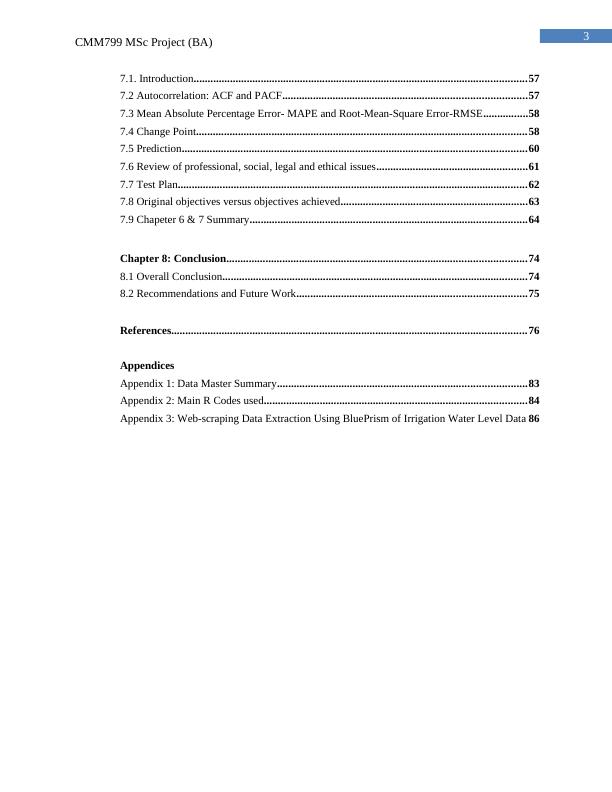
4
CMM799 MSc Project (BA)
Topic: Predicting the impact of rainfall on paddy harvest and its ultimate effect on
agricultural loans in banks in Sri Lanka
Chapter 1: Introduction
1.1. Problem Statement
The purpose of this research report is to predict the impact of one identified
environmental hazard i.e. rainfall, on the agricultural loan loss experience in banks of Sri Lanka.
It is essential to evaluate the contribution of rainfall on the agricultural loan loss in order to
identify the possible risk mitigation solution. For this, extensive literature search and collection
of data from secondary sources is essential.
1.2. Research Questions
This section of the research report will discuss major research questions this particular
research study will address. The research questions identified for this research are as follows-
1. What is the historical quantitative experience of loan losses as represented by Non-
Performing Loan ratio in banks of Sri Lanka in the last twenty years (1998 to 2017)?
2. What is the historical quantitative experience of agricultural loan losses, as a percentage or
ratio in banks of Sri Lanka as impacted by rainfall in the last ten years (2008 to 2017)?
3. How well can rainfall caused historical agricultural and total loan loss experience related
to paddy cultivation be used in the prediction of future agricultural loan losses related to
paddy cultivation in banks in Sri Lanka?
4. How well can knowledge that is gathered in this predictive formula, contribute to the
developing of innovative loan products and other risk mitigants against the agricultural
loan losses related to paddy cultivation?
CMM799 MSc Project (BA)
Topic: Predicting the impact of rainfall on paddy harvest and its ultimate effect on
agricultural loans in banks in Sri Lanka
Chapter 1: Introduction
1.1. Problem Statement
The purpose of this research report is to predict the impact of one identified
environmental hazard i.e. rainfall, on the agricultural loan loss experience in banks of Sri Lanka.
It is essential to evaluate the contribution of rainfall on the agricultural loan loss in order to
identify the possible risk mitigation solution. For this, extensive literature search and collection
of data from secondary sources is essential.
1.2. Research Questions
This section of the research report will discuss major research questions this particular
research study will address. The research questions identified for this research are as follows-
1. What is the historical quantitative experience of loan losses as represented by Non-
Performing Loan ratio in banks of Sri Lanka in the last twenty years (1998 to 2017)?
2. What is the historical quantitative experience of agricultural loan losses, as a percentage or
ratio in banks of Sri Lanka as impacted by rainfall in the last ten years (2008 to 2017)?
3. How well can rainfall caused historical agricultural and total loan loss experience related
to paddy cultivation be used in the prediction of future agricultural loan losses related to
paddy cultivation in banks in Sri Lanka?
4. How well can knowledge that is gathered in this predictive formula, contribute to the
developing of innovative loan products and other risk mitigants against the agricultural
loan losses related to paddy cultivation?
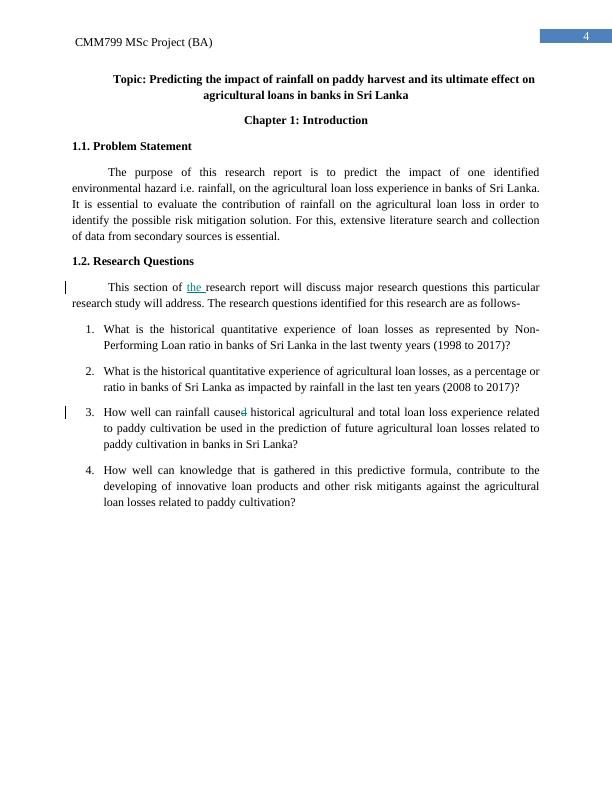
5
CMM799 MSc Project (BA)
1.3. Background of the Study
1.3.1. Importance of agriculture in Sri Lanka
Sri Lanka is a developing agricultural country of South Asian Region, which is self-
sufficient in rice, vegetables, and tropical fruits. Along with that, Sri Lanka is one of the major
exporters of plantation crop products such as tea, coconut, rubber, and spices in the Asian region.
As per the 2017 Annual Report of Central Bank of Sri Lanka, agriculture as an economic activity
contributed LKR 1,024 Billion to the overall GDP of LKR 13,289 Billion. Further, the same
report shows that agriculture as an economic activity employs 2,140 Million persons out of 8,208
Million total labor force of the country. (Table 56 of CBSL 2017 Annual Report). Therefore
undoubtedly, agriculture represents a key economic activity of the country.
Out of the agriculture economic activity, the main crops that lead the contribution to GDP
are growing of tea, coconut, and paddy (Table 2.1 of CBSL 2017 Annual Report). Paddy as a
cereal crop is cultivated in many districts of the country, wherein the top 10 paddy cultivating
districts contributed 78% of the total production of the county in 2008, which proportion in the
year 2017 was 73%. (Department of Agriculture www.doa.gov.lk accessed March 2019).
1.3.2. Importance of agriculture loans in Sri Lanka
A large proportion of agricultural cultivation activities is supported by various loan and
financing schemes provided by banks and financial institutions. Therefore, agricultural loans
provided by banks for cultivation, is an important economic activity. (Cbsl.gov.lk. 2018). An
agricultural loan can be described as a financial facility that is used to meet the cost of farming
and cultivation activities associated with agriculture and business (Beck and De Jonghe 2013, pp
2). These types of loans are mainly low low-interest loans that farmers generally avail to run
their cultivation and farming businesses efficiently. Since Sri Lanka is a developing agricultural
country, it increasingly relies on the special loan schemes provided by banks and financial
institutions (Laeven and Valencia 2013). The different loan schemes offered are “Krushi
Navodaya Loan Scheme”, “Kapruka Ayojana Loan Scheme”, “Agro Livestock Development
Loan Scheme” and others (Beck 2013). Thus, Sri Lankan banks ensure appropriate allocation of
loans for agriculture, while meeting the business demands as well as regulations of Central Bank
of Sri Lanka which require all banks to provide at least 10% of the loans to agriculture sector
(Cbsl.gov.lk. 2018). According to the schemes and the rules of the loans, the farmers need to
repay their loans after harvesting and selling their crops. Agricultural loans in Sri Lanka can be
availed by all the eligible farmers to fund the seasonal agricultural operations and similar
activities, which include farming, crops or purchase of agricultural tools. (Ariyadasa et al. 2017).
The agricultural land proportion in Sri Lanka was estimated to be 43.69% in the year
2018. Sri Lanka has agricultural land of nearly 27400 sq. km (Tradingeconomics.com. 2018). In
Sri Lanka, there are two main cultivation seasons namely Maha and Yala
(Statistics.gov.lk.2018)). The cultivation seasons are named according to the two monsoon
CMM799 MSc Project (BA)
1.3. Background of the Study
1.3.1. Importance of agriculture in Sri Lanka
Sri Lanka is a developing agricultural country of South Asian Region, which is self-
sufficient in rice, vegetables, and tropical fruits. Along with that, Sri Lanka is one of the major
exporters of plantation crop products such as tea, coconut, rubber, and spices in the Asian region.
As per the 2017 Annual Report of Central Bank of Sri Lanka, agriculture as an economic activity
contributed LKR 1,024 Billion to the overall GDP of LKR 13,289 Billion. Further, the same
report shows that agriculture as an economic activity employs 2,140 Million persons out of 8,208
Million total labor force of the country. (Table 56 of CBSL 2017 Annual Report). Therefore
undoubtedly, agriculture represents a key economic activity of the country.
Out of the agriculture economic activity, the main crops that lead the contribution to GDP
are growing of tea, coconut, and paddy (Table 2.1 of CBSL 2017 Annual Report). Paddy as a
cereal crop is cultivated in many districts of the country, wherein the top 10 paddy cultivating
districts contributed 78% of the total production of the county in 2008, which proportion in the
year 2017 was 73%. (Department of Agriculture www.doa.gov.lk accessed March 2019).
1.3.2. Importance of agriculture loans in Sri Lanka
A large proportion of agricultural cultivation activities is supported by various loan and
financing schemes provided by banks and financial institutions. Therefore, agricultural loans
provided by banks for cultivation, is an important economic activity. (Cbsl.gov.lk. 2018). An
agricultural loan can be described as a financial facility that is used to meet the cost of farming
and cultivation activities associated with agriculture and business (Beck and De Jonghe 2013, pp
2). These types of loans are mainly low low-interest loans that farmers generally avail to run
their cultivation and farming businesses efficiently. Since Sri Lanka is a developing agricultural
country, it increasingly relies on the special loan schemes provided by banks and financial
institutions (Laeven and Valencia 2013). The different loan schemes offered are “Krushi
Navodaya Loan Scheme”, “Kapruka Ayojana Loan Scheme”, “Agro Livestock Development
Loan Scheme” and others (Beck 2013). Thus, Sri Lankan banks ensure appropriate allocation of
loans for agriculture, while meeting the business demands as well as regulations of Central Bank
of Sri Lanka which require all banks to provide at least 10% of the loans to agriculture sector
(Cbsl.gov.lk. 2018). According to the schemes and the rules of the loans, the farmers need to
repay their loans after harvesting and selling their crops. Agricultural loans in Sri Lanka can be
availed by all the eligible farmers to fund the seasonal agricultural operations and similar
activities, which include farming, crops or purchase of agricultural tools. (Ariyadasa et al. 2017).
The agricultural land proportion in Sri Lanka was estimated to be 43.69% in the year
2018. Sri Lanka has agricultural land of nearly 27400 sq. km (Tradingeconomics.com. 2018). In
Sri Lanka, there are two main cultivation seasons namely Maha and Yala
(Statistics.gov.lk.2018)). The cultivation seasons are named according to the two monsoon

6
CMM799 MSc Project (BA)
seasons. A substantial proportion of farmers depend on financing and credit methods extended
for cultivation. Therefore, it is essential for the banks to analyze and estimate the risks associated
with the granting of the agricultural loans Chisasa, J., and Makina, 2013, p. 1).
The agricultural loans that are granted for supporting the farming activities are subjected
to a number of risks (Chisasa, J. and Makina, 2013). Identification, analysis, and addressing of
these risks are not only essential from the lender’s perspective. It is also beneficial to the
borrowers as the loan interest rates, when determined with adequate quantitative support such as
this research, will provide a lower risk-based interest charge. One of the major risks that are
identified in this context that can affect the repaying of the loans is environmental factors.
(Birner 2018, p 25). The loss of crops as a result of environmental hazards can in turn, in turn,
result in significant loss of the banks that are granting loans for farming activities (Birner 2018, p
50). Thus, the risk related to the market involves different environmental factors such as adverse
weather conditions along with other natural perils that can destroy the crops (Birner 2018, p 50).
Therefore, it can be said that the environmental damage not only brings about significant
losses to the farmers and livestock production, it also affects the large banks of Sri Lanka. Thus,
it is essential for the banks to consider mitigation strategies for the risks that are associated with
the implementation of another project management (Beck 2013). It is essential to understand that
the risks associated with the natural conditions required to carry out agricultural activities that
are not under the control of the borrowers. The banks that are lending money to the borrower
need to introduce several reforms such as diversification strategies, collaboration with the
institution, regulatory intervention and other innovative strategies for management and reduction
of the risks associated with types of agricultural loans (Laeven and Valencia 2014).
1.3.3. Importance of this study into the impact of rainfall on paddy harvest and its
ultimate effect on agricultural loans in banks in Sri Lanka
The farming community depends on bank loans to finance the working capital.
Agricultural lending is identified as a critical part of the business for several financial
institutions, especially in rural sectors. The finance provided by the bank is essential for the
families in developing new agricultural techniques and technologies. However, the banks
involved in financing the crops and livestock’s have assumed that the risks related to market
involve environmental factors such as adverse weather conditions and other natural perils. The
net effect of such adversaries is associated to with changes in crop yields and livestock
production. These risks are not under borrower’s control and therefore the banks need to
introduce several reforms such as diversification strategies, collaborating with institutions,
regulatory interventions, developing more innovative products, knowledge management and
community of practice (Carter, Cheng and Sarris 2016). However, in practice what takes place is
that banks pass the risk of loan losses to borrowers inside the interest rate charged from farmers,
as this risk is yet an ‘unquantified guess’ rather than a scientifically estimated and quantified
risk. Having the ability to assess and predict the risk of loan losses at the outset potentially
CMM799 MSc Project (BA)
seasons. A substantial proportion of farmers depend on financing and credit methods extended
for cultivation. Therefore, it is essential for the banks to analyze and estimate the risks associated
with the granting of the agricultural loans Chisasa, J., and Makina, 2013, p. 1).
The agricultural loans that are granted for supporting the farming activities are subjected
to a number of risks (Chisasa, J. and Makina, 2013). Identification, analysis, and addressing of
these risks are not only essential from the lender’s perspective. It is also beneficial to the
borrowers as the loan interest rates, when determined with adequate quantitative support such as
this research, will provide a lower risk-based interest charge. One of the major risks that are
identified in this context that can affect the repaying of the loans is environmental factors.
(Birner 2018, p 25). The loss of crops as a result of environmental hazards can in turn, in turn,
result in significant loss of the banks that are granting loans for farming activities (Birner 2018, p
50). Thus, the risk related to the market involves different environmental factors such as adverse
weather conditions along with other natural perils that can destroy the crops (Birner 2018, p 50).
Therefore, it can be said that the environmental damage not only brings about significant
losses to the farmers and livestock production, it also affects the large banks of Sri Lanka. Thus,
it is essential for the banks to consider mitigation strategies for the risks that are associated with
the implementation of another project management (Beck 2013). It is essential to understand that
the risks associated with the natural conditions required to carry out agricultural activities that
are not under the control of the borrowers. The banks that are lending money to the borrower
need to introduce several reforms such as diversification strategies, collaboration with the
institution, regulatory intervention and other innovative strategies for management and reduction
of the risks associated with types of agricultural loans (Laeven and Valencia 2014).
1.3.3. Importance of this study into the impact of rainfall on paddy harvest and its
ultimate effect on agricultural loans in banks in Sri Lanka
The farming community depends on bank loans to finance the working capital.
Agricultural lending is identified as a critical part of the business for several financial
institutions, especially in rural sectors. The finance provided by the bank is essential for the
families in developing new agricultural techniques and technologies. However, the banks
involved in financing the crops and livestock’s have assumed that the risks related to market
involve environmental factors such as adverse weather conditions and other natural perils. The
net effect of such adversaries is associated to with changes in crop yields and livestock
production. These risks are not under borrower’s control and therefore the banks need to
introduce several reforms such as diversification strategies, collaborating with institutions,
regulatory interventions, developing more innovative products, knowledge management and
community of practice (Carter, Cheng and Sarris 2016). However, in practice what takes place is
that banks pass the risk of loan losses to borrowers inside the interest rate charged from farmers,
as this risk is yet an ‘unquantified guess’ rather than a scientifically estimated and quantified
risk. Having the ability to assess and predict the risk of loan losses at the outset potentially
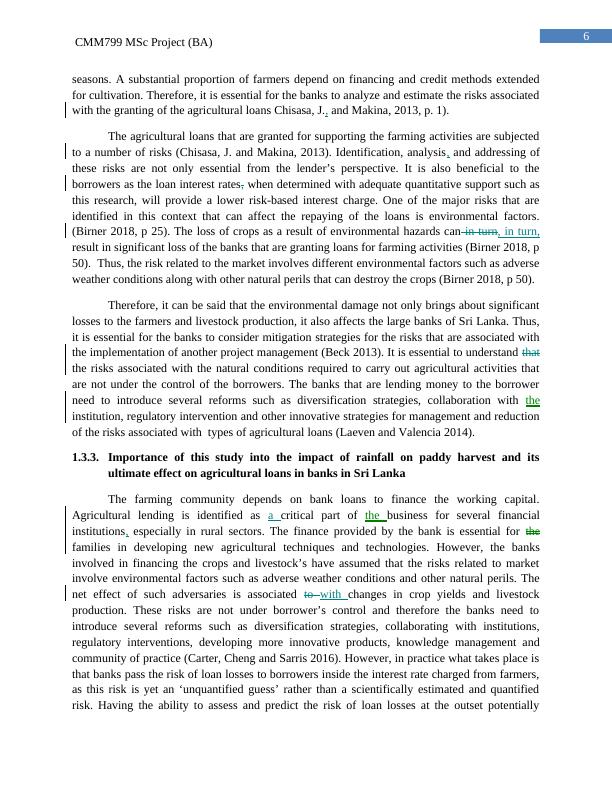
7
CMM799 MSc Project (BA)
arising from natural conditions such as rainfall variations will help banks as well as borrowers to
have effective financing mechanisms. That is because on one hand, from the perspective of
banks, they are able to appropriately charge interest based on the risk of rainfall variations on the
agricultural loans and on the other, the borrowers will be able to get a better risk priced
agricultural loan without a premium added for the so far ‘unquantified guess’.
Literature search done revealed that research work has earlier been conducted in which
the effect of weather was examined generally fall into: 1) research focusing on meteorological
impact in Europe (Flechsig et al. 2000); 2) Impact analysis in specific economic sectors (Starr-
McCluer 2000; Loisel and Elyakime 2006; Deschênes and Greenstone 2007); and 3and
3)subjective estimations on sensitivity of hazards in weather (Dutton 2002). However, a study
has not been done so far focusing on Sri Lanka, analyzing the economic impact of weather that
results in agricultural loan losses in large banks.
This research project has been undertaken in order to predict the extent of the impact of
the most important ingredient for cultivation- i.e. rainfall on the harvest and thereby the losses in
agricultural loans. Rainfall is the dilemma of the farmer as the right amount at the right time can
bring the optimal harvest, while excessive or deficient as well as untimely rainfall can cause
environmental hazards. Such would also direct losses on agricultural loans provided by banks in
Sri Lanka (Birner 2018, p 50). The banks cannot stop providing financial help to the farmers on
account of the losses faced due to environmental hazards. The research report will identify the
major impacts of the rainfall on bank losses and will further predict the possibility of developing
new strategies of reducing the losses associated with lending of agricultural loans.
As per the Central Bank of Sri Lanka Directions, all its regulated entities of Sri Lanka are
required to provide agricultural loans to the borrowers. (Cbsl.gov.lk. 2018). This is compulsory
for all the banks including large and medium medium-sized banks. The banking sector of Sri
Lanka is well capitalized and well regulated (Cbsl.gov.lk. 2018).. The Sri Lankan banking sector
is therefore, therefore, one of the fast-growing sectors in Sri Lanka. However, the loan losses
from agricultural loan give rise to a major concern associated with the financial stability (Chisasa
and Makina 2013). One of the major reasons behind the same can be the fact that the Sri Lanka’s
banks are generally more challenged in terms of innovation, efficiency and value added. Coupled
with that, the natural disasters increase the amount of loses that are faced by both the farmers and
the banks that are lending them money for farming ((Li et al. 2013)
In the recent years, the banking sector of Sri Lanka has become large and quickly
expanding in terms of coverage to industries including agriculture. Thus, it is essential for the
banks in Sri Lanka to identify the approaches and strategies that can help in mitigating of risk or
reducing the risks associated with the agricultural loan loss (Beck and De Jonghe 2013, p 5). In
this context, the different challenges associated with the agricultural lending are needed to be
identified. Farming is a risky business and its profitability is entirely dependent on the
profitability of the crops. There are a number of reasons due to which a crop might fail. Crops
CMM799 MSc Project (BA)
arising from natural conditions such as rainfall variations will help banks as well as borrowers to
have effective financing mechanisms. That is because on one hand, from the perspective of
banks, they are able to appropriately charge interest based on the risk of rainfall variations on the
agricultural loans and on the other, the borrowers will be able to get a better risk priced
agricultural loan without a premium added for the so far ‘unquantified guess’.
Literature search done revealed that research work has earlier been conducted in which
the effect of weather was examined generally fall into: 1) research focusing on meteorological
impact in Europe (Flechsig et al. 2000); 2) Impact analysis in specific economic sectors (Starr-
McCluer 2000; Loisel and Elyakime 2006; Deschênes and Greenstone 2007); and 3and
3)subjective estimations on sensitivity of hazards in weather (Dutton 2002). However, a study
has not been done so far focusing on Sri Lanka, analyzing the economic impact of weather that
results in agricultural loan losses in large banks.
This research project has been undertaken in order to predict the extent of the impact of
the most important ingredient for cultivation- i.e. rainfall on the harvest and thereby the losses in
agricultural loans. Rainfall is the dilemma of the farmer as the right amount at the right time can
bring the optimal harvest, while excessive or deficient as well as untimely rainfall can cause
environmental hazards. Such would also direct losses on agricultural loans provided by banks in
Sri Lanka (Birner 2018, p 50). The banks cannot stop providing financial help to the farmers on
account of the losses faced due to environmental hazards. The research report will identify the
major impacts of the rainfall on bank losses and will further predict the possibility of developing
new strategies of reducing the losses associated with lending of agricultural loans.
As per the Central Bank of Sri Lanka Directions, all its regulated entities of Sri Lanka are
required to provide agricultural loans to the borrowers. (Cbsl.gov.lk. 2018). This is compulsory
for all the banks including large and medium medium-sized banks. The banking sector of Sri
Lanka is well capitalized and well regulated (Cbsl.gov.lk. 2018).. The Sri Lankan banking sector
is therefore, therefore, one of the fast-growing sectors in Sri Lanka. However, the loan losses
from agricultural loan give rise to a major concern associated with the financial stability (Chisasa
and Makina 2013). One of the major reasons behind the same can be the fact that the Sri Lanka’s
banks are generally more challenged in terms of innovation, efficiency and value added. Coupled
with that, the natural disasters increase the amount of loses that are faced by both the farmers and
the banks that are lending them money for farming ((Li et al. 2013)
In the recent years, the banking sector of Sri Lanka has become large and quickly
expanding in terms of coverage to industries including agriculture. Thus, it is essential for the
banks in Sri Lanka to identify the approaches and strategies that can help in mitigating of risk or
reducing the risks associated with the agricultural loan loss (Beck and De Jonghe 2013, p 5). In
this context, the different challenges associated with the agricultural lending are needed to be
identified. Farming is a risky business and its profitability is entirely dependent on the
profitability of the crops. There are a number of reasons due to which a crop might fail. Crops
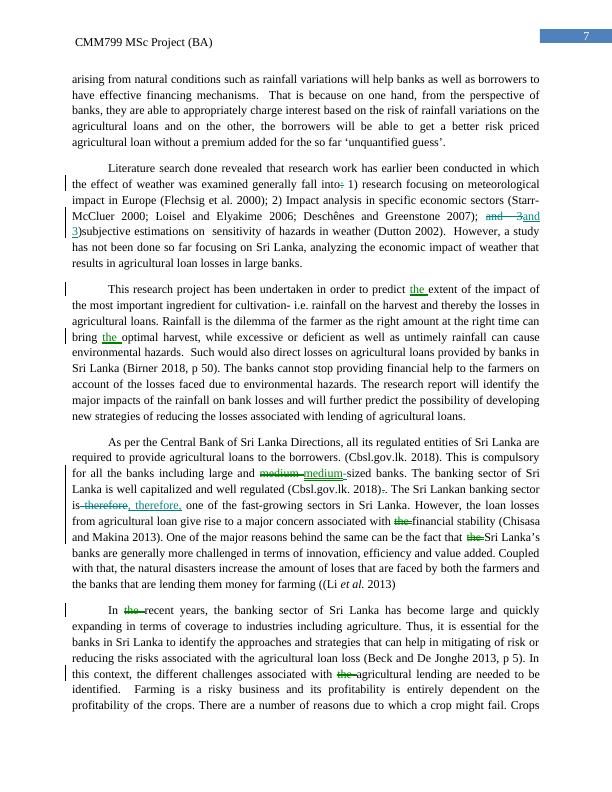
End of preview
Want to access all the pages? Upload your documents or become a member.
Related Documents
Predicting the Impact of Rainfall on Paddy Harvest and Agricultural Loans in Sri Lankalg...
|99
|36298
|69
Predicting the Impact of Environmental Hazards on Agricultural Loan Loss Experience in Large Banks in Sri Lankalg...
|63
|18533
|174
Analyze the leadership qualities required in the constructionlg...
|101
|20074
|5
XXX in China: Marketing Strategies for Expansionlg...
|68
|16736
|25
STRM044 : Business Research Projectlg...
|70
|15996
|60
Industry Project Report on Commercial Cleaning Companieslg...
|47
|11857
|243
